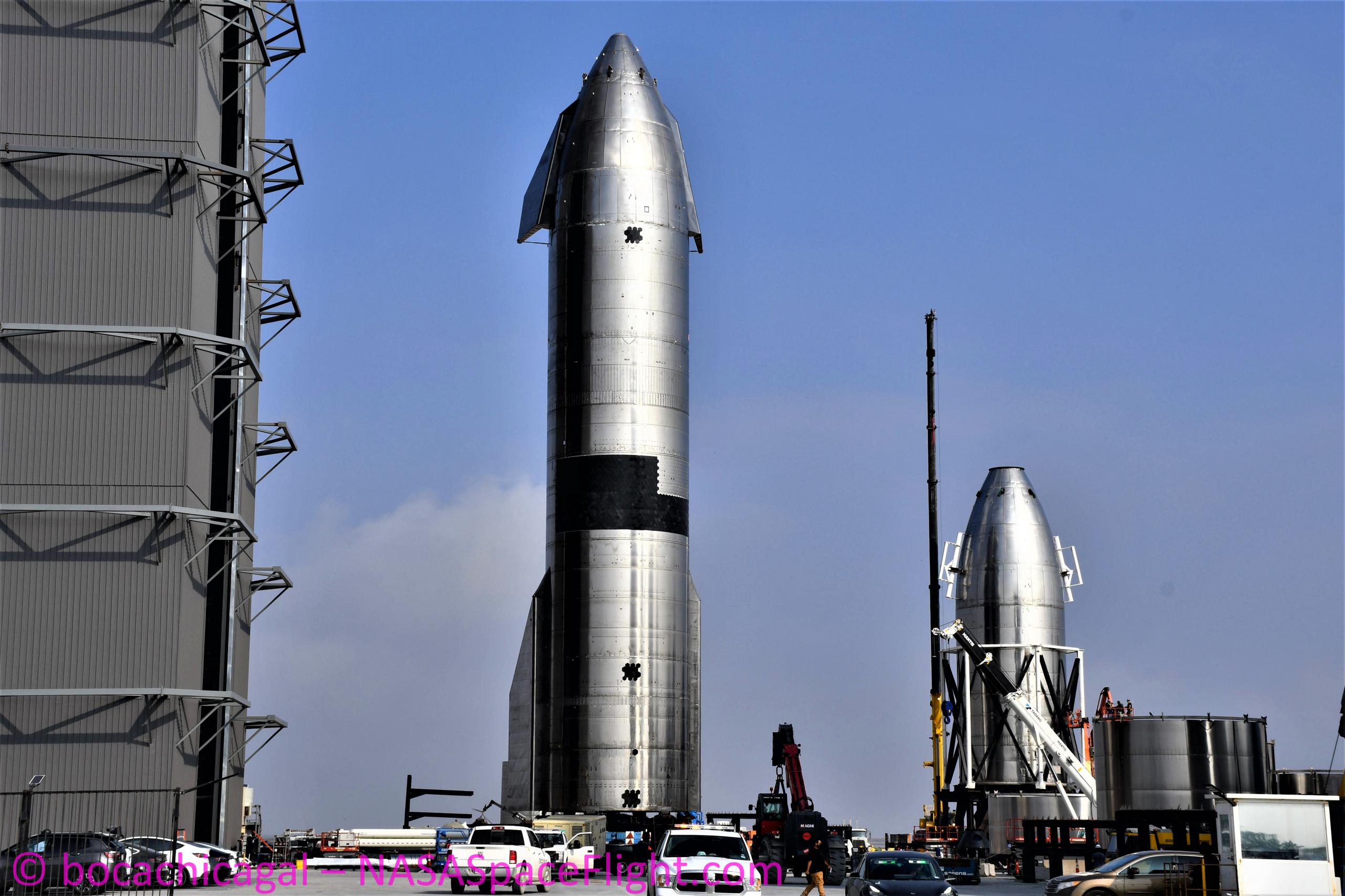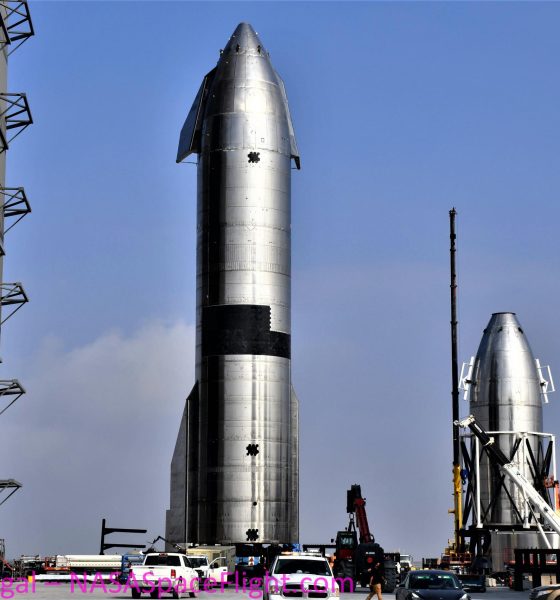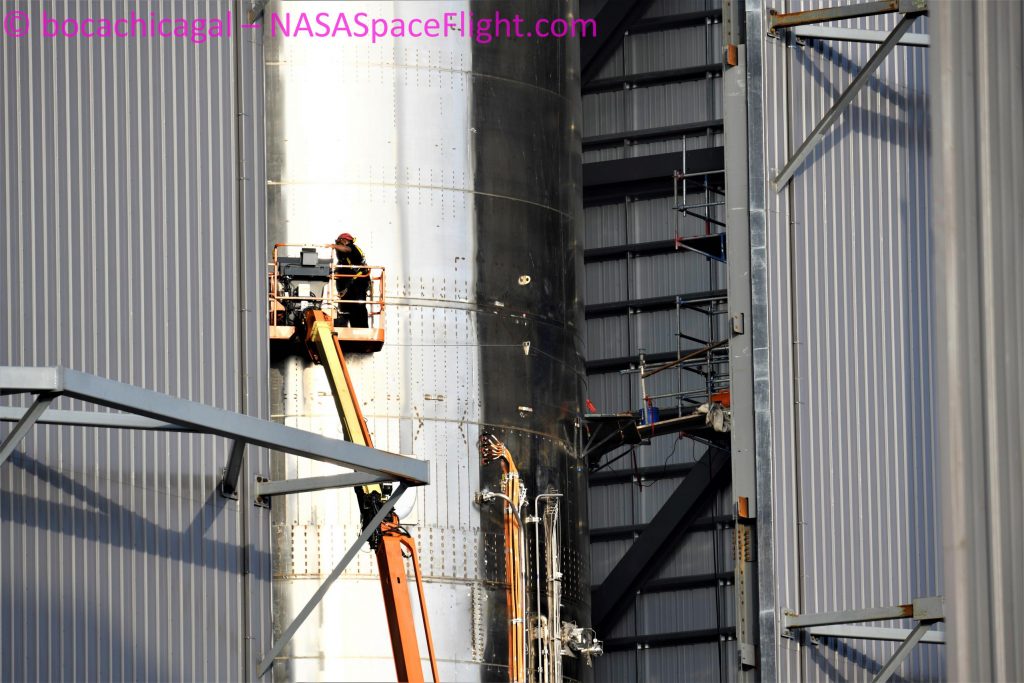

News
SpaceX rolls next Starship to the launch pad nine days after midair explosion
Update: Right on schedule, SpaceX has transported Starship serial number 15 (SN15) from its Boca Chica rocket factory to a launch and test site just down the road.
SN15’s pad arrival comes just nine days after Starship SN11 – the last in a batch of four first-generation prototypes – exploded in midair some 30 seconds before a planned landing. While minor, SN11’s midair failure was undoubtedly a step backward relative to Starship SN10, which (briefly) became the first full-size prototype to land in one piece less than a month prior. Both SN8, SN9, and SN10 made it further into their identical flight tests, leaving SN11 somewhat high and dry and putting extra pressure on Starship SN15.
After Starship SN8’s unexpectedly successful December 2020 test flight, in which the rocket made it just a dozen or so seconds away from soft landing after more than six minutes in flight, SpaceX made the decision to scrap Starship SN12 and kill SN13 and SN14 before assembly could begin. Effectively a gamble that SN8-SN11 would produce enough of a foundation for future testing to start off on, it’s hard to say if that gamble paid off.
All four Starship flights managed the extraordinary feat of more than four minutes of powered flight and spent two minutes free-falling like no rocket ever before them, but they also made it clear that both Raptor and autogenous pressurization (using gasified propellant to pressurize Starship’s tanks) are not quite mature enough for reliable launches and landings. Featuring “hundreds of improvements,” many of which were hopefully designed to tackle some of those shortcomings, it’ll be up to Starship SN15 to attempt to carry that torch forward – and, with any luck, further than any prototype before it.
After SpaceX unexpectedly used a Monday road closure to deliver its first custom-built rocket fuel tank, plans for the next Starship test campaign and launch have begun to solidify.
Most importantly, the initial schedule for Starship serial number 15’s (SN15) test campaign appears to be clear. As of Wednesday, April 7th, road closures filed by SpaceX suggest that the first of a new group of upgraded Starships will be transported from build site to launch pad as early as 11am-1:30pm CDT (UTC-5) on Thursday, April 8th. Once SN15 is installed on ‘Suborbital Pad A,’ SpaceX means to waste no time and has scheduled a 7am-12pm road closure on Friday.
As usual, the weekend will once again be free of any testing or activity requiring road closures, but SpaceX has already cordoned off noon to 8pm on Monday and Tuesday (April 12/13) to continue putting its newest Starship prototype to the test.

While road closure notices no longer offer any real detail, a few basic details can still be inferred. The April 7th closure, for example, warns that SpaceX only plans to intermittently close the highway but not Boca Chica Beach – implying that the window poses no threat to residents or beachgoers. Historically, that means that something will be transported – likely Starship SN15, in this case.
On Friday, SpaceX has scheduled a full five-hour closure of both the highway and beach, implying that some kind of testing is likely on the books. The same goes for Monday and Tuesday, but with longer eight-hour closures.
More likely than not, assuming Starship SN15’s pad transport and launch mount installation goes smoothly, SpaceX will use the shorter Friday window to complete a basic ambient pressure test – filling the rocket with ambient-temperature nitrogen gas to test its complex plumbing and propellant tanks for leaks. Continuing the IFF (if and only if) string, SpaceX will then spend the weekend preparing Starship SN15 for a cryogenic proof test and thrust structure stress test – simulating the thrust of three Raptors after loading the rocket with extremely cold liquid nitrogen (LN2).
SpaceX will then most likely spend another one or two days inspecting Starship SN15 and removing the hydraulic ram used to simulated thrust from the launch mount the ship is installed on. Once SN15 and its mount are cleared, SpaceX can move into static fire testing. Given that – according to CEO Elon Musk – SN15 will debut Raptor engines with an unknown degree of upgrades, it’s reasonable to assume that SpaceX will take things relatively slowly and possibly perform more than one static fire test even if the first attempt is a total success.
If not and SpaceX continues to push hard like it did with SN10 and SN11, it’s not out of the question that Starship SN15 will be ready for its first launch attempt around Friday, April 16th or Monday, April 19th. Stay tuned for updates as SpaceX hopefully rolls the rocket to its Boca Chica, Texas launch site later today.

News
Tesla China quietly posts Robotaxi-related job listing
Tesla China is currently seeking a Low Voltage Electrical Engineer to work on circuit board design for the company’s autonomous vehicles.

Tesla has posted a new job listing in Shanghai explicitly tied to its Robotaxi program, fueling speculation that the company is preparing to launch its dedicated autonomous ride-hailing service in China.
As noted in the listing, Tesla China is currently seeking a Low Voltage Electrical Engineer to work on circuit board design for the company’s autonomous vehicles.
Robotaxi-specific role
The listing, which was shared on social media platform X by industry watcher @tslaming, suggested that Tesla China is looking to fill the role urgently. The job listing itself specifically mentions that the person hired for the role will be working on the Low Voltage Hardware team, which would design the circuit boards that would serve as the nervous system of the Robotaxi.
Key tasks for the role, as indicated in the job listing, include collaboration with PCB layout, firmware, mechanical, program management, and validation teams, among other responsibilities. The role is based in Shanghai.
China Robotaxi launch
China represents a massive potential market for robotaxis, with its dense urban centers and supportive policies in select cities. Tesla has limited permission to roll out FSD in the country, though despite this, its vehicles have been hailed as among the best in the market when it comes to autonomous features. So far, at least, it appears that China supports Tesla’s FSD and Robotaxi rollout.
This was hinted at in November, when Tesla brought the Cybercab to the 8th China International Import Expo (CIIE) in Shanghai, marking the first time that the autonomous two-seater was brought to the Asia-Pacific region. The vehicle, despite not having a release date in China, received a significant amount of interest among the event’s attendees.
Elon Musk
Elon Musk and Tesla AI Director share insights after empty driver seat Robotaxi rides
The executives’ unoccupied tests hint at the rapid progress of Tesla’s unsupervised Robotaxi efforts.

Tesla CEO Elon Musk and AI Director Ashok Elluswamy celebrated Christmas Eve by sharing personal experiences with Robotaxi vehicles that had no safety monitor or occupant in the driver’s seat. Musk described the system’s “perfect driving” around Austin, while Elluswamy posted video from the back seat, calling it “an amazing experience.”
The executives’ unoccupied tests hint at the rapid progress of Tesla’s unsupervised Robotaxi efforts.
Elon and Ashok’s firsthand Robotaxi insights
Prior to Musk and the Tesla AI Director’s posts, sightings of unmanned Teslas navigating public roads were widely shared on social media. One such vehicle was spotted in Austin, Texas, which Elon Musk acknowleged by stating that “Testing is underway with no occupants in the car.”
Based on his Christmas Eve post, Musk seemed to have tested an unmanned Tesla himself. “A Tesla with no safety monitor in the car and me sitting in the passenger seat took me all around Austin on Sunday with perfect driving,” Musk wrote in his post.
Elluswamy responded with a 2-minute video showing himself in the rear of an unmanned Tesla. The video featured the vehicle’s empty front seats, as well as its smooth handling through real-world traffic. He captioned his video with the words, “It’s an amazing experience!”
Towards Unsupervised operations
During an xAI Hackathon earlier this month, Elon Musk mentioned that Tesla owed be removing Safety Monitors from its Robotaxis in Austin in just three weeks. “Unsupervised is pretty much solved at this point. So there will be Tesla Robotaxis operating in Austin with no one in them. Not even anyone in the passenger seat in about three weeks,” he said. Musk echoed similar estimates at the 2025 Annual Shareholder Meeting and the Q3 2025 earnings call.
Considering the insights that were posted Musk and Elluswamy, it does appear that Tesla is working hard towards operating its Robotaxis with no safety monitors. This is quite impressive considering that the service was launched just earlier this year.
Elon Musk
Starlink passes 9 million active customers just weeks after hitting 8 million
The milestone highlights the accelerating growth of Starlink, which has now been adding over 20,000 new users per day.

SpaceX’s Starlink satellite internet service has continued its rapid global expansion, surpassing 9 million active customers just weeks after crossing the 8 million mark.
The milestone highlights the accelerating growth of Starlink, which has now been adding over 20,000 new users per day.
9 million customers
In a post on X, SpaceX stated that Starlink now serves over 9 million active users across 155 countries, territories, and markets. The company reached 8 million customers in early November, meaning it added roughly 1 million subscribers in under seven weeks, or about 21,275 new users on average per day.
“Starlink is connecting more than 9M active customers with high-speed internet across 155 countries, territories, and many other markets,” Starlink wrote in a post on its official X account. SpaceX President Gwynne Shotwell also celebrated the milestone on X. “A huge thank you to all of our customers and congrats to the Starlink team for such an incredible product,” she wrote.
That growth rate reflects both rising demand for broadband in underserved regions and Starlink’s expanding satellite constellation, which now includes more than 9,000 low-Earth-orbit satellites designed to deliver high-speed, low-latency internet worldwide.
Starlink’s momentum
Starlink’s momentum has been building up. SpaceX reported 4.6 million Starlink customers in December 2024, followed by 7 million by August 2025, and 8 million customers in November. Independent data also suggests Starlink usage is rising sharply, with Cloudflare reporting that global web traffic from Starlink users more than doubled in 2025, as noted in an Insider report.
Starlink’s momentum is increasingly tied to SpaceX’s broader financial outlook. Elon Musk has said the satellite network is “by far” the company’s largest revenue driver, and reports suggest SpaceX may be positioning itself for an initial public offering as soon as next year, with valuations estimated as high as $1.5 trillion. Musk has also suggested in the past that Starlink could have its own IPO in the future.








